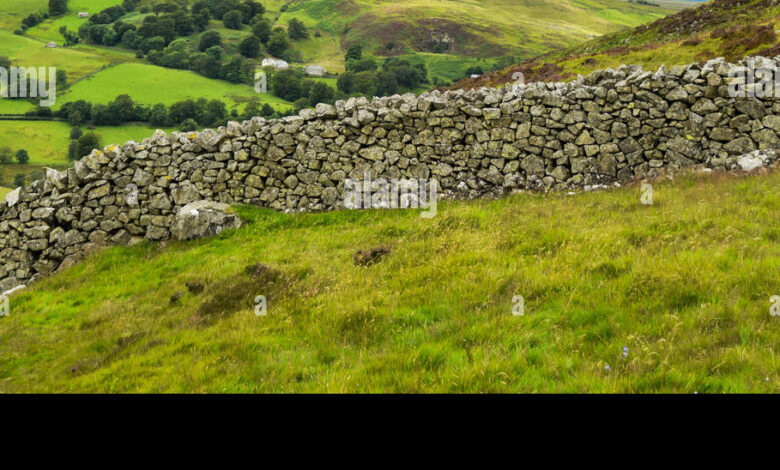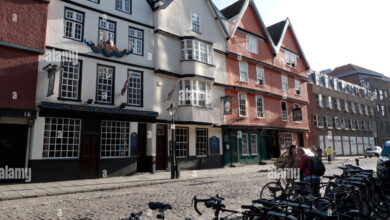Fell Wall: Meaning, Origins, and Historical Significance Explained

A fell wall is one of the most distinctive and enduring features of the British countryside. These traditional stone boundaries, often seen snaking across the hills of Northern England and Scotland, have stood for centuries — silent witnesses to the evolution of rural life. Constructed without mortar using locally sourced stones, fell walls were originally built to mark land divisions, contain livestock, and protect valuable farmland from erosion and wind.
The word “fell” itself comes from the Old Norse fjall, meaning “hill” or “mountain,” which reflects the landscapes where these walls are most common — rugged, windswept uplands like the Lake District, the Yorkshire Dales, and the Scottish Highlands. Each fell wall tells a story, shaped by geography, climate, and human ingenuity.
But fell walls are more than just practical barriers; they are symbols of endurance, craftsmanship, and cultural identity. In this article, we’ll explore the origins, construction, and modern relevance of these iconic stone structures — celebrating the heritage they represent and the beauty they bring to the countryside.
The History and Origins of Fell Walls
The history of fell walls dates back hundreds, if not thousands, of years. Early settlers and farmers in Britain began stacking stones to form boundaries and enclosures long before written records existed. As communities grew and land became more valuable, these walls became essential for managing grazing areas and protecting livestock from straying onto neighboring lands.
By the medieval period, dry stone walling had evolved into a refined rural craft. The expansion of agriculture during the 18th and 19th centuries, particularly after the Enclosure Acts, saw an explosion in the construction of fell walls across the British landscape. Land that was once common pasture was enclosed with these walls, turning open countryside into a patchwork of defined plots.
Each region developed its own style based on local stone availability. In Cumbria, slate and volcanic rock gave walls a rough, rugged texture. In the Yorkshire Dales, limestone created a cleaner, more uniform look. Regardless of location, these structures were built by hand — often by farmers themselves or skilled wallers — using nothing but strength, balance, and an eye for precision.
Today, many fell walls remain from those centuries, a living testament to rural craftsmanship and human perseverance against nature’s challenges.
The Craftsmanship Behind Fell Walls
Building a fell wall is as much an art as it is a science. The technique used, known as dry stone walling, involves carefully selecting and stacking stones so that they interlock naturally, without the use of mortar or cement. This method relies on gravity, friction, and geometry — making the wall both strong and flexible enough to withstand shifting ground and harsh weather conditions.
The foundation is crucial: large base stones are laid flat and secure, forming the wall’s stable footing. Smaller “hearting” stones fill gaps in the interior, while larger “through stones” span the width of the wall for added strength. Finally, “coping stones” or “capstones” are placed on top to lock everything together and protect the wall from rain damage.
The craftsmanship lies in the balance between form and function. A well-built fell wall not only stands for generations but also blends seamlessly with the landscape, appearing as though it has grown from the earth itself. Traditional tools such as hammers, chisels, and line markers guide the process, but the most valuable tools are the builder’s eyes and hands.
Despite modern fencing alternatives, dry stone walling remains a respected heritage skill. Many organizations in the UK, like the Dry Stone Walling Association, continue to train new generations of wallers to preserve this timeless art.
The Cultural and Environmental Significance of Fell Walls

Fell walls are deeply woven into Britain’s rural identity. They reflect centuries of tradition and embody the resourcefulness of communities that thrived in challenging environments. For many farmers and villagers, building and maintaining these walls was a collective task — a way of shaping the land while preserving a sense of belonging.
Beyond their cultural value, fell walls play an essential environmental role. Unlike modern fences, they provide habitats for a variety of wildlife. The small crevices between stones become homes for insects, lizards, and even small mammals like voles and shrews. Mosses, lichens, and ferns flourish on their shaded surfaces, contributing to local biodiversity.
Visually, fell walls define the character of the British countryside. Their serpentine lines follow the natural contours of the land, creating picturesque scenery beloved by hikers, photographers, and tourists. In places like the Lake District, these stone boundaries are as iconic as the fells themselves — a perfect blend of human craftsmanship and natural beauty.
Thus, each fell wall serves as a bridge between past and present, culture and nature — a reminder that sustainable craftsmanship can coexist harmoniously with the environment.
Modern Uses and Challenges
In the modern world, the practical use of fell walls has evolved. While many still serve their original purpose of containing livestock, others are now preserved as historical landmarks or integrated into conservation projects. Farmers continue to value them for their durability and low maintenance — a well-built wall can last hundreds of years if properly cared for.
However, fell walls face increasing challenges. Harsh weather, erosion, and neglect have caused many old walls to crumble. Urban expansion and changes in agricultural practices have also reduced the demand for traditional walling. Without consistent maintenance, these historic structures risk disappearing from the landscape altogether.
Thankfully, preservation efforts are growing. Organizations such as the National Trust and local heritage groups actively fund restoration projects, ensuring that skilled wallers can continue their work. Workshops and community initiatives encourage young people to learn dry stone walling, keeping the craft alive.
In a time when sustainability and heritage are gaining renewed importance, the fell wall stands as a symbol of resilience — proof that practical design and natural materials can outlast centuries of change.
Building Your Own Fell Wall: A Practical Overview
Constructing a fell wall requires patience, precision, and respect for tradition. The first step is choosing the right location and gathering suitable stone. Local materials are always best, as they blend naturally with the landscape and handle the area’s weather patterns effectively.
Next comes the foundation. Large, flat stones are laid first to create a sturdy base. Each subsequent layer must be carefully balanced, with smaller stones filling the interior gaps for support. As the wall rises, through stones are added periodically to tie both sides together. The finishing touch — coping stones — is laid at the top to shield the wall from rain and to give it structural integrity.
Maintenance is key to longevity. Regular inspections help identify loose stones or small collapses before they worsen. Vegetation should be trimmed back to prevent roots from dislodging the wall. With proper care, a well-constructed fell wall can easily last several generations, standing as both a functional barrier and a piece of living history.
Conclusion: Why Fell Walls Still Matter Today
Fell walls are more than rural relics — they are enduring symbols of human creativity, heritage, and connection to the land. Their strength lies not only in their physical construction but also in their cultural significance. They remind us of a time when craftsmanship, community, and sustainability were intertwined.
In an age dominated by concrete and steel, the humble fell wall continues to inspire admiration for its beauty, utility, and resilience. Preserving these structures ensures that future generations can walk the same hills, see the same walls, and appreciate the timeless bond between people and nature. Truly, fell walls are not just built on the land — they are built from it.
FAQs About Fell Walls
What exactly is a fell wall?
A fell wall is a traditional dry stone boundary found mainly in Northern England and Scotland, built without mortar to mark land divisions or contain livestock.
Where are fell walls most commonly found?
They’re most prevalent in the Lake District, Yorkshire Dales, and Scottish Highlands — regions with abundant natural stone.
How old are some fell walls?
Many existing walls date back to the 18th and 19th centuries, though some may be far older.
Why are fell walls built without mortar?
Dry stone construction allows the wall to “breathe” and flex with the ground, making it more durable in harsh climates.
How do fell walls benefit the environment?
They provide habitats for small animals and plants, helping support biodiversity in rural ecosystems.
Can anyone learn to build a fell wall?
Yes! Many heritage organizations offer dry stone walling workshops for beginners interested in traditional building techniques.
You May Also Read: Star Trek Joke




